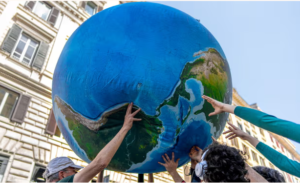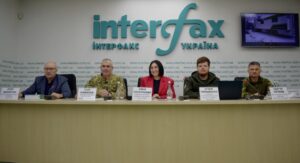
As temperatures rise and countries back off their decarbonization efforts, we must confront a reality central banks can’t correct
Inflation is, at base, a tax on consumption – and it hits the poor the hardest, since they consume more of their incomes and the rich consume less.
That’s one reason for concern over Donald Trump’s tariffs, which will disproportionately affect the poor. When the 90-day pause on the tariffs expires, it is reasonable to expect prices to rise, and by a lot.
That’s because, first, intermediate goods – rather than finished ones – dominate trade, crossing borders and being tariffed multiple times along the way, which makes them highly inflationary. Second, while the tariffs of the first Trump administration could be more easily absorbed by exchange rates and producers, there is no way tariffs of this magnitude can be absorbed. Producers and consumers must take a hit, and that means rising prices. It looks like the poor, once again, will suffer the most.
But if Trump’s tariffs were to disappear for good, would we return to a world of stable prices? Insights from our forthcoming book, Inflation: A Guide for Users and Losers, suggest that is sadly not the case, for three reasons.
The first is how we think about inflation and how we respond to it. We identified four distinct ways that the public and central banks have talked about the causes and effects of inflation in the past few years. The first story is the textbook idea that “the government spends too much money”. The second focuses on wages pushing up prices – a labor market story. These two stories both see inflation as coming from demand outpacing supply. Consumers demand too much because governments put too much money in their pockets, and workers ask for higher wages despite no significant improvements in productivity. If production can’t keep up with the surge in demand, then the inevitable consequence will be rising prices.
The two other stories we identified see inflation the other way around. It’s the supply side of the economy that generated inflation. There’s the “supply shocks” story, where unexpected events such as Covid or the Ukraine war push up prices and they stay up until the economy adjusts. And finally, there is the story of corporations in concentrated markets using inflation as cover to raise prices.
There is evidence for (and against) all four causal stories. But what policymakers tended to focus on were the first two. As a result, central banks raised interest rates, which can be effective in reducing inflation when it is demand-driven but cannot do much if inflation comes from an exogenous shock, such as Covid or a war.
What is interesting about the 2020s inflation was that the latter two stories – supply shocks and opportunistic corporations – turned out to be just as, if not more, important than the first two.
But is that all there is to future inflation? No, and that brings us to reason number two.
The Trump administration has recently declared a war on climate change research inside the federal government and in the wider US research community, as well as a doubling down on carbon-based business models. But wishing the problem away won’t make it disappear. The real drivers of future inflation are not just tariffs, but the climate crisis and states backing off their decarbonization efforts.
Climate change is already affecting prices. The first driver for this is insurance markets. A combination of massively rising damage costs from droughts, wildfires and floods has seen insurance costs soar in many countries. Some insurers have moved to cut coverage in US states such as California and Florida, with the result that the state there is on the hook for damages it can never cover. Recognizing this, reinsurers – the companies that protect insurance firms – are pulling their coverage from insurance writers, creating a long-term rise in prices. The effects spread well beyond insurance markets. In the US you cannot get a mortgage or build without insurance. Housing is already in critically short supply. Prices can only go up.
The climate crisis is also having long-term effects on what we eat. The Potsdam Institute for Climate Impact Research and the European Central Bank have produced the first systematic assessments of how much climate change will impact inflation through impacts on food supplies. Assuming temperature increases projected through 2035, which are probably understated, food inflation will increase by 0.92 to 3.23% per year, while headline inflation will rise between 0.32 and 1.18% per year. US wildfires and Europe’s recent and persistent droughts and crop failures are really just the thin end of this inflationary wedge.
Finally, there is the question of how everyone else responds to the US breaking the current global order. The UK’s nationalization of a primary steel company, the move to expand Heathrow airport, and more spending on defense all suggest that our attempts to decarbonize our economies are being put on hold in the name of adjusting to these new realities. The US has effectively given up trying to do anything about it and has decided instead to “drill, baby, drill”.
The EU’s Green Deal was already in trouble electorally, and Trump’s decisions have moved the drive for rearmament to the top of the priorities queue. Meanwhile, China’s decarbonization model depends upon everyone else buying its green tech, which itself is built with enormous coal input. Any long-term financial bonus we might get through the lower costs of more installed renewables and lesser climate damage will be much less than anticipated, even a few years ago, as we backpedal on decarbonization.
In short, viewing tariffs as a source of inflation is probably a good idea. But in doing so we should not miss the underlying forces that no amount of central bank tinkering can accommodate – and that we refuse to fully confront.
https://www.theguardian.com/commentisfree/2025/apr/22/tariffs-inflation-climate-crisis
Climate crisis, ECONOMICS, INFLATION, OPINION, Trump tariffs

Ukraine needs to simplify the bureaucracy in the work and accounting of charitable foundations and volunteers, said Artem Honcharenko, president of the Reconstruction and Development of Ukraine Foundation, a volunteer.
“I am in favor of simplifying the procedure for transferring charitable aid to recipients, simplifying the bureaucracy in the work of charitable foundations and volunteers. I know from my own experience how much time is spent on paperwork and bureaucracy. For example, a person who is at “zero” on the frontline has to write us an application, according to which we have to collect everything and give him or her a certificate to sign that he or she has received our help. I have an example when a person for whom we were collecting aid died while we were filling out all the paperwork,” he said during a roundtable discussion at the Interfax-Ukraine news agency on Thursday.

Goncharenko noted that one way to simplify the processing of aid provided by charities and volunteers is to fill out and submit documents online.
“We need to simplify the procedure. I am speaking here on behalf of all the foundations, I think they support me in this: we need to simplify this system or allow us to fill it out online. Then people will be able to fill it out, and we will be able to ship them the aid,” he said.
Honcharenko also emphasized the need to regulate the issue of VAT taxation of goods purchased and delivered by charitable foundations and volunteers.
“We need to remove VAT from these goods. When we imported the first mobile hospital, it cost EUR 230 thousand, and the VAT amounted to another EUR 50 thousand,” he said.

In his turn, Serhiy Petkov, Doctor of Law, military officer, emphasized the need to use online tools in the process of receiving social assistance and payments, in particular for veterans and military personnel.
At the same time, he noted that in Ukraine, “for some reason, issues are resolved at the level of bylaws, and this should not be the case in a democratic state governed by the rule of law, legislation should be codified.”
“All these bylaws, various resolutions, instructions, letters, explanations, etc. should become a thing of the past, we need to move away from manual control and move to a normal democratic legal life so that everything happens in accordance with the law,” he said.

For his part, Doctor of Law, professor, volunteer Ihor Kopotun noted that there is no need to develop a separate regulatory framework for social protection of military personnel and veterans.
“I think we don’t need to invent anything. Today, the social protection of servicemen or any person must meet the requirements of the current legislation, the social protection provided by the laws. Everyone should be equal before the law, and the laws that have already been adopted today should be implemented,” he said.
bureaucracy, CHARITY, GONCHARENKO, mobile hospital, OPINION, Petkov, VOLUNTEERS, Копотун

Until the end of 2020, the hryvnia will remain at the level of UAH 28/$1 with further strengthening to UAH 27-27.5/$1 in the first half of 2021, Oleksandr Martynenko, the head of the ICU Investment Group’s corporate financial analysis division, says.
“At the end of this year, as we expect, the upper possible corridor of the range will be UAH 28.5/$1, but most likely, the hryvnia will be closer to the lower range of UAH 28/$1,” Martynenko said during an online conference.
Speaking about the forecast of the exchange rate for 2021, Martynenko noted expectations of UAH 27-27.5/$1 against the background of exporters’ activity in the first half of next year, however, in the future, the transition to a deficit in the payment account may put pressure on the exchange rate.
“So far, the hryvnia is showing a higher resilience than previously expected. Mainly due to the greater activity of exporters and favorable markets for iron ore and steel,” he explained.
ICU expects capital inflows to resume in 2021 through private foreign investment and official borrowing. In addition, capital outflow will stop next year, Martynenko said.
“Foreign exchange reserves will increase, somewhere, by $ 3 billion, to $ 31 billion in 2021. That is, for the first time since the crisis of 2008-2009, the reserves should exceed 100% according to the metrics of a sufficient amount, which the IMF calculates,” Martynenko added.

The Expert Club jointly with Doctor of Biological Sciences Sviatoslav Leonov launch a series of videos about healthy and harmful nutrition.
Nowadays unhealthy nutrition is one of the main risk factors for public health. A major study of mortality causes, which was conducted by researchers in 2017, showed that every fifth death in the world is caused by high consumption of salt, transfat, sugar, overconsumption of sweet carbonated beverages and red meat. Meanwhile, healthy food like whole grain, fruit, seeds and nuts are gradually displaced by harmful products.
In 2017, more than 1.5 million people in the world died of diseases connected with diarrhea caused by poor nutrition. Food poisoning and unhealthy eating in general have been among the top ten causes for deaths for a long time, and in some countries – among the top three causes.
The Expert Club jointly with Doctor of Biological Sciences Sviatoslav Leonov start a project on healthy nutrition in modern society. It is aimed at determining the main risk factors related to unhealthy nutrition, discussing myths and stereotypes, collecting expert opinions on the subject. Initially, the project will have the format of educational mini-interviews with infographics. In the future, we are planning to create a discussion platform for specialists with various points of view.
The pilot video about the main unhealthy food products and harmful food additives is already available on the Expert Club YouTube channel:

President of Ukraine International Airlines (UIA) Yevhen Dykhne does not see any reasons for airlines to raise airfare at the initial stage of lockdown ending.
During the press conference on Saturday, June 13, the video of which is available on the page of Boryspil International Airport, he said that all airlines today have excess resources, and at the same time very low demand is expected for their services, which will be compensated by all possible means.
“Therefore, it is absolutely logical that all instruments, including low prices, will be included in the fight against excess resources between companies for low demand and low passenger numbers. Due to this, insinuating that the additional costs of airlines and airports will somehow affect the airfare, in my opinion, is not justified. Today, the airfare is defined by the market’s supply-demand situation. Thus, I think that aviation will start operation from very low prices, affordable flights at a loss,” Dykhne said.
He also said that UIA communicates with all passengers who bought tickets for the airline’s flights, considering options for transferring flight dates, compensation using a voucher, or refund.